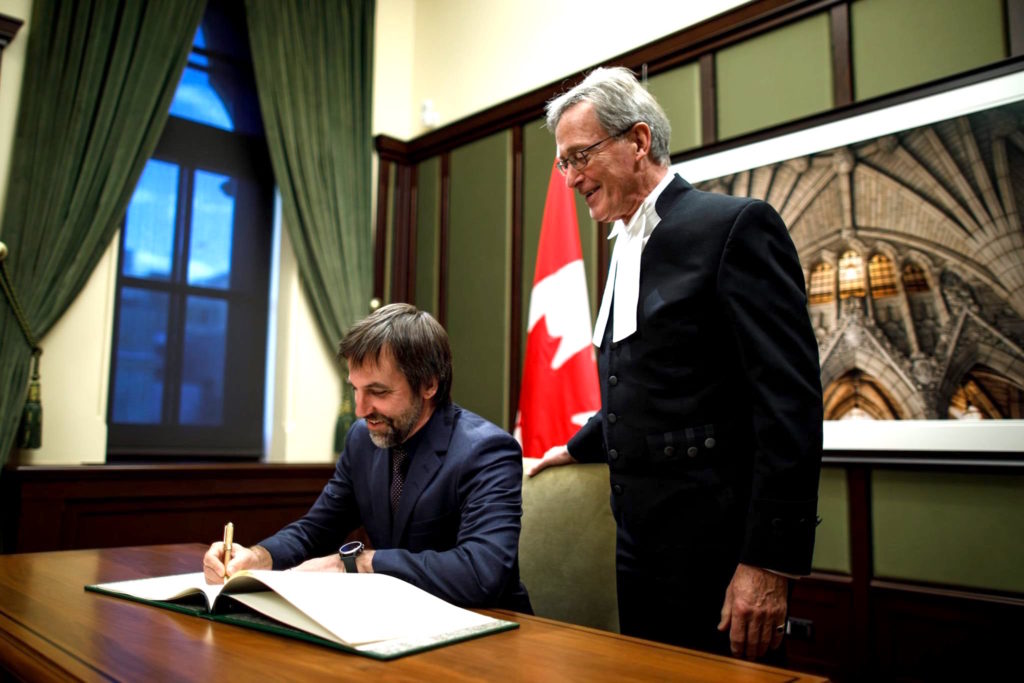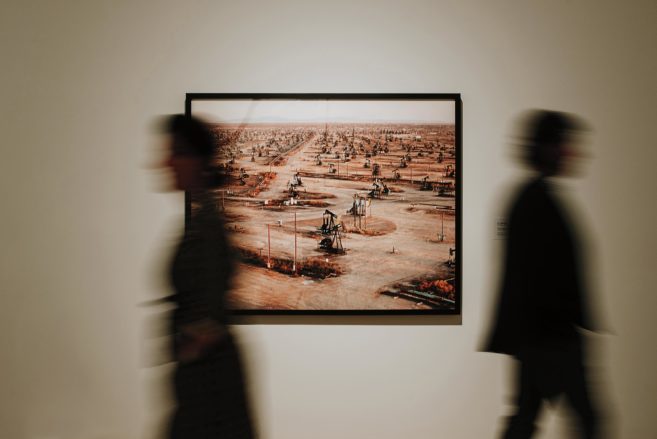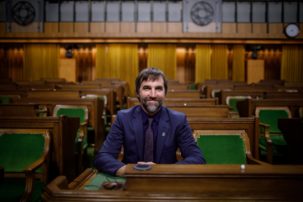For more than a decade, Steven Guilbeault led the Quebec nonprofit Équiterre. For a decade more, he worked in other forms of activism, including at Greenpeace. Now, as a rookie Montreal MP, he’s taking on Canada’s biggest arts and culture portfolio. Here, in a condensed interview held a few days into his work as minister of Canadian heritage, Guilbeault reflects on what’s ahead—including intersections between the climate crisis and Canada’s art galleries and museums.
Leah Sandals: Arts audiences are just getting to know you. In that vein, can you share some of your favourite artists, artworks or arts venues?
Steven Guilbeault: In music, I know it’s a bit of a cliché, but I’m a big fan of the Tragically Hip. And the Montreal Museum of Fine Arts is wonderful.
I’ve been to the Symposium international d’art contemporain de Baie-Saint-Paul a couple times. My wife is a huge fan; she goes almost every year. Her grandfather was deputy minister for arts and culture in Quebec and was director of the fine arts museum in Quebec City, so I take many of my cues from her.
I like to read a lot. I thought I should brush up on political history of the last 150 years in Canada, so I’m reading a book about that right now. The last novel I read was by Dany Laferrière. And I’m looking forward to reading The Testaments [by Margaret Atwood].
I’m the author of three books, which are nonfiction, [and] that does give me a sense of what it is to work with an editor, and be distributed. I get copyright cheques every now and then. Though I certainly won’t be quitting my day job!
LS: Just a few weeks ago, National Galleries Scotland said it would no longer host the BP Portrait Award exhibition due to the climate-related ethical concerns. Given your long history in climate activism and your new role overseeing the culture file, to what extent would you like to see Canadian museums or Canadian art constituencies address relationships between oil companies and cultural institutions?
SG: I think that’s one thing we’ve been seeing from the arts and culture sector in general—this raising of awareness.
When I was at Équiterre, we had a partnership with an Inuit organization [the Fédération des coopératives du Nouveau-Québec], which involved art. First, we purchased a bronze sculpture from a British artist [Mark Coreth], and then with his permission we froze a block of ice over it. Then, Inuit artists [including Peter Boy Ittukallak] sculpted the ice into the shape of a polar bear, and we put it outside. As the ice melted, the bear disappeared and only a bronze skeleton remained.
I think climate change and environmental issues shouldn’t just be left to government. I welcome the fact that more and more people, and certainly artists, are becoming very engaged. It’s not something I’m going to impose to the sector, but maybe accompany if I can—or if we can as a government. It is a government priority. It’s very clear to us.
LS: Even more recently, there was a protest at a British Museum exhibition opening by a group called “BP or not BP?” Having been involved in notable public protests in the past yourself, like scaling the CN Tower in 2001 to draw attention to climate change, how would you encourage Canadian art institutions to deal with such protests should they start to gain momentum in Canada?
SG: Well, if I have any piece of advice, it would be to reach out. I think dialogue is a very important component of this. Yes, I did climb the CN Tower and did a couple of other stunts, but most of my activism was based on establishing dialogue—working with people who 10 or 15 years ago really didn’t pay a lot of attention, but through dialogue we’re able to move forward together.
I co-founded a nonprofit called SWITCH, the Alliance for a Green Economy in Quebec. We had people from the financial sector, the business sector, the trade unions, from time to time NGOs. Obviously, we had our differences, but we agreed on a certain number of things, and decided we could work together on those things.
So I if can offer a piece of advice, dialogue would be it.
LS: You mention Inuit art is one of your interests…
SG: I’m a big fan. But I’m not a connoisseur. There was a fabulous exhibition I saw two years ago in Quebec City at the Pierre Lassonde Pavilion [at the Musée national des beaux-arts du Québec], featuring works from the Brousseau collection. Absolutely wonderful.
The Vancouver airport is one of my favourite airports in the world because of its collection of Inuit art and West Coast Indigenous art. Beautiful. It changes the atmosphere so much.
LS: Yes. A lot of Inuit artists in Canada have been waiting the better part of a decade for something called an artist resale right, which means they (and other artists) would get money every time their work is resold. Your colleague MP Julie Dabrusin headed a parliamentary study this year which said an artist resale right needs to be established, and she heard evidence on how long some have been advocating for it. By contrast, I saw wealthy art collectors and museum directors get art-donation tax laws changed in their favour after just eight months of campaigning in 2018 and 2019—which results in substantial benefits to them. When will our laws and rules be changed to benefit artists and not just wealthy collectors and museum directors?
SG: Today is my fifth or sixth day on the job, and I must confess it is the first time I’ve heard about that. All I can say is I will turn to my esteemed colleagues from the ministry and I will look into it. I promise you I will do that.
LS: Thanks for speaking to that. There’s also a group in Canada called the Coalition of Museums for Climate Justice. Some of its members say that museums are some of the most energy inefficient buildings in Canada, and conversely, that museums could be very effective community tools for disseminating information about climate change. What do you think of those perspectives?
SG: Well, through our green infrastructure program, there’s a lot of money available for a whole host of different organizations or institutions—museums included—to try and get greener.
I was one of the “architects” of a project in Montreal called La Maison du developpement durable. It’s right beside the Théâtre du Nouveau Monde. It’s a LEED Platinum building which was built without any support from the federal government, because when we did it, it was the Harper years.
In this 68,000-square-foot building, they save thousands of dollars annually in their energy bill [because of sustainable design]. And it’s an amazing magnet. It gets lots of visitors every year—schools, professionals, people who can just stop by.
We were hoping to do some kind of “museum for clean technologies in the building sector” inside; we didn’t get quite enough money to do it. But the first two floors are open to the public; there are some interactive display panels where you can learn about geothermal energy and greener building materials for construction. There’s a five-storey-high wall of plants that filters the air in the building.
So I totally agree with people who say that museums can be an important tool to communicate and disseminate information. And if museums or any other institutions want to do things like that, there can be support at the federal level—and some provinces too, actually—to do that.
LS: I know you were at the Ontario Association of Art Galleries Awards recently in Toronto. What’s next for you in getting up to speed on the sector?
SG: A day or two after I became minister, I asked the [Ministry of Canadian Heritage] team if we could organize a trip to Toronto. It’s only early days on the job, but Toronto is such an important hub for arts and culture, I wanted to make sure I came.
I know I have a lot to learn. You can learn a lot by reading reports and sitting in an office, but I believe in being in contact with people and learning from their experiences and their challenges. I don’t know a lot about the [arts] sector, but coming from a community organizing background, I do know the reality of having to find some money here and some money there, and having to be a bit of a gymnast to be able to sustain an organization. And the sense I’m getting from my fifth or sixth day on the job is that this is a reality for many organizations and institutions in the arts and culture sector.
I may not know the fine details, but I understand the challenges and I want people to know that I will be an ally—I am an activist, not just an environmental activist. I intend to be as much of an activist for arts and culture as I am for the environment.
This interview has been edited and condensed.

 Steven Guilbeault being sworn in as MP for Laurier-Sainte-Marie on November 15, 2019. A few days later, he was named Minister of Canadian Heritage. Photo: via Facebook / used with ministry permission.
Steven Guilbeault being sworn in as MP for Laurier-Sainte-Marie on November 15, 2019. A few days later, he was named Minister of Canadian Heritage. Photo: via Facebook / used with ministry permission.






